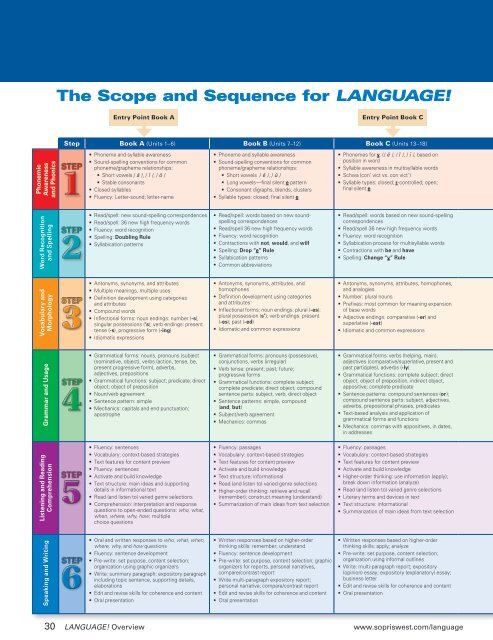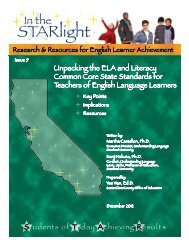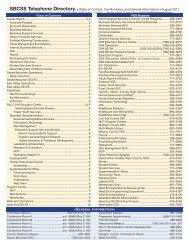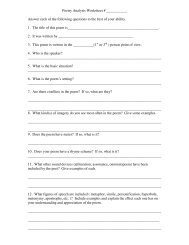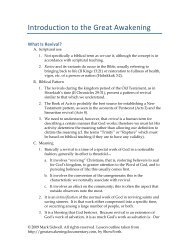4th Edition LANGUAGE! Overview
4th Edition LANGUAGE! Overview
4th Edition LANGUAGE! Overview
You also want an ePaper? Increase the reach of your titles
YUMPU automatically turns print PDFs into web optimized ePapers that Google loves.
The Scope and Sequence for <strong>LANGUAGE</strong>!Entry Point Book AEntry Point Book CStep Book A (Units 1–6) Book B (Units 7–12) Book C (Units 13–18)PhonemicAwarenessand Phonics• Phoneme and syllable awareness• Sound-spelling conventions for commonphoneme/grapheme relationships:• Short vowels / ă /, / ĭ /, / ŏ /• Stable consonants• Closed syllables• Fluency: Letter-sound; letter-name• Phoneme and syllable awareness• Sound-spelling conventions for commonphoneme/grapheme relationships:• Short vowels / ĕ /, / ŭ /• Long vowels—final silent e pattern• Consonant digraphs, blends, clusters• Syllable types: closed; final silent e• Phonemes for y, (/ ĕ /, / ĭ /, / ī /, based onposition in word• Syllable awareness in multisyllable words• Schwa (con’ vict vs. con vict’)• Syllable types: closed; r-controlled; open;final silent eWord Recognitionand Spelling• Read/spell: new sound-spelling correspondences• Read/spell: 36 new high frequency words• Fluency: word recognition• Spelling: Doubling Rule• Syllabication patterns• Read/spell: words based on new soundspellingcorrespondences• Read/spell 36 new high frequency words• Fluency: word recognition• Contractions with not, would, and will• Spelling: Drop “e” Rule• Syllabication patterns• Common abbreviations• Read/spell: words based on new sound-spellingcorrespondences• Read/spell 36 new high frequency words• Fluency: word recognition• Syllabication process for multisyllable words• Contractions with be and have• Spelling: Change “y” RuleVocabulary andMorphology• Antonyms, synonyms, and attributes• Multiple meanings, multiple uses• Definition development using categoriesand attributes• Compound words• Inflectional forms: noun endings: number (-s),singular possessions (‘s); verb endings: presenttense (-s), progressive form (-ing)• Idiomatic expressions• Antonyms, synonyms, attributes, andhomophones• Definition development using categoriesand attributes• Inflectional forms: noun endings: plural (-es);plural possession (s’); verb endings: present(-es); past (-ed)• Idiomatic and common expressions• Antonyms, synonyms, attributes, homophones,and analogies• Number: plural nouns• Prefixes: most common for meaning expansionof base words• Adjective endings: comparative (-er) andsuperlative (-est)• Idiomatic and common expressionsGrammar and Usage• Grammatical forms: nouns, pronouns (subject(nominative, object), verbs (action, tense, be,present progressive form), adverbs,adjectives, prepositions• Grammatical functions: subject; predicate; directobject; object of preposition• Noun/verb agreement• Sentence pattern: simple• Mechanics: capitals and end punctuation;apostrophe• Grammatical forms: pronouns (possessive),conjunctions, verbs (irregular)• Verb tense: present; past; future;progressive forms• Grammatical functions: complete subject;complete predicate; direct object; compoundsentence parts: subject, verb, direct object• Sentence patterns: simple, compound(and, but)• Subject/verb agreement• Mechanics: commas• Grammatical forms: verbs (helping, main),adjectives (comparative/superlative, present andpast participles), adverbs (-ly)• Grammatical functions: complete subject; directobject, object of preposition, indirect object,appositive; complete predicate• Sentence patterns: compound sentences (or);compound sentence parts: subject, adjectives,adverbs, prepositional phrases, predicates• Text-based analysis and application ofgrammatical forms and functions• Mechanics: commas with appositives, in dates,in addressesListening and ReadingComprehension• Fluency: sentences• Vocabulary: context-based strategies• Text features for content preview• Fluency: sentences• Activate and build knowledge• Text structure: main ideas and supportingdetails in informational text• Read (and listen to) varied genre selections• Comprehension: interpretation and responsequestions to open-ended questions: who, what,when, where, why, how; multiplechoice questions• Fluency: passages• Vocabulary: context-based strategies• Text features for content preview• Activate and build knowledge• Text structure: informational• Read (and listen to) varied genre selections• Higher-order thinking: retrieve and recall(remember); construct meaning (understand)• Summarization of main ideas from text selection• Fluency: passages• Vocabulary: context-based strategies• Text features for content preview• Activate and build knowledge• Higher-order thinking: use information (apply);break down information (analyze)• Read (and listen to) varied genre selections• Literary terms and devices in text• Text structure: informational• Summarization of main ideas from text selectionSpeaking and Writing• Oral and written responses to who, what, when,where, why, and how questions• Fluency: sentence development• Pre-write: set purpose, content selection;organization using graphic organizers• Write: summary paragraph; expository paragraphincluding topic sentence, supporting details,elaborations• Edit and revise skills for coherence and content• Oral presentation• Written responses based on higher-orderthinking skills: remember; understand• Fluency: sentence development• Pre-write: set purpose, content selection; graphicorganizers for reports, personal narratives,compare/contrast report• Write multi-paragraph expository report;personal narrative; compare/contrast report• Edit and revise skills for coherence and content• Oral presentation• Written responses based on higher-orderthinking skills: apply; analyze• Pre-write: set purpose, content selection;organization using informal outlines• Write: multi-paragraph report; expository(opinion) essay; expository (explanatory) essay;business letter• Edit and revise skills for coherence and content• Oral presentation30 <strong>LANGUAGE</strong>! <strong>Overview</strong> www.sopriswest.com/language


